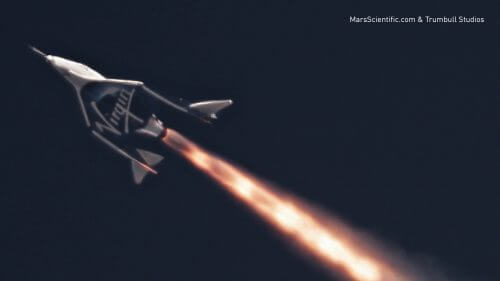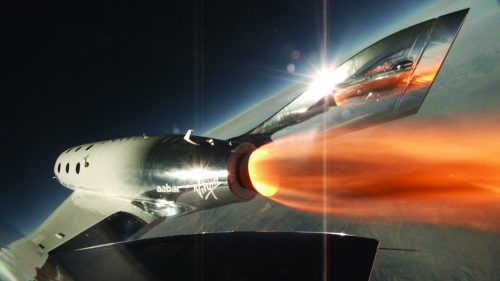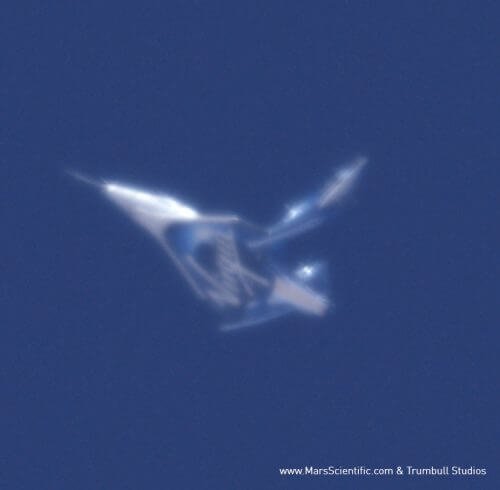"During the test, important data was collected on the performance of the flight, the engine and the aircraft, which our engineers will check. This test marks a key moment for the test program, and we are entering the exciting phase of longer-term use of the rockets. ” said the company's announcement.


Virgin Galactic announced on Thursday, 5/4/2018 the first test of the spacecraft's rocket engine since the crash of the Enterprise spacecraft (the first spacecraft of the Space-Ship-2 series) in 2014, during which one pilot was killed and his companion was seriously injured.
Enterprise's successor Unity successfully completed its first rocket-powered flight on Friday after two years of extensive testing on the ground and in the air. This milestone, the company says, marks the beginning of the final part of Unity's experimental program.
The flight was also significant for the Mojave company that produced Unity, which is the first space vehicle to be created from scratch for Virgin Galactic.
"VSS Unity benefits from all the data and lessons learned from the test flights of its predecessor, VSS Enterprise. Today's flight represents the expansion of the envelope for the entire program in terms of rocket burn duration, speed and flight altitude." They say in the company.
"VSS Unity took off into the skies of the Mojave Desert at 8:02 a.m. with Mark "Forger" Stuckey and Dave McKay in the cockpit, along with Mike Massucci and Nicola Pasilla who were in the White Knight 2 "Eve" carrier aircraft. Both aircraft climbed to a launch altitude of approx. -46,500 feet above the Sierra Nevada mountains and Eve pilots then performed a clean Unity release. A few seconds later, Unity's rocket engines were fired and the pilots pointed the spacecraft upward to climb at an 80 degree angle. During the 30 seconds of engine burn they reached a speed of Mach 1.87. This was Unity's first supersonic flight."

“After the rockets were turned off, Unity continued to climb until it reached an altitude of 84,271 feet before beginning its descent. At this point, the pilots raised the tail of the spacecraft to an angle of 60 degrees in a configuration known as a "feather". According to the company, this unique design feature, which is the key to reliable re-entry capability for a winged vehicle, incorporates the additional safety mechanisms adopted after the VSS Enterprise flight accident in 2014. At about 50,000 feet, the tail was lowered again and the remaining oxidizer in the fuel tanks was dumped, then Unity turned toward Mojave for a smooth landing at the home port.”
"During the test, important data was collected on the performance of the flight, the engine and the aircraft, which our engineers will check. This test marks a key moment for the test program, and we are entering the exciting phase of longer-term use of the rockets. ” said the company's announcement.
As mentioned, the issue of the acceleration missiles of a Space Ship 2 spacecraft was of great importance, because the failure of Enterprise occurred immediately after it separated from the carrier plane and ignited the missiles, due to human error by the co-pilot, who released the braking mechanism 10 seconds too early and caused a structural failure. The safety researchers of the Ministry of Transportation in the United States determined during 2015 that due to the release of the mechanism, aerodynamic forces activated the brakes on the aircraft, which ultimately led to the crash that occurred during the test flight on October 31 in the Mojave Desert. The investigators added that there were no measures to overcome the mistake made by the co-pilot, Michael Ellsbury, who was killed in the crash.
Virgin Galactic, owned by billionaire Richard Branson, plans to fly six passengers in a spaceship on each flight that will reach an altitude of over 100 kilometers, observe the sphericity of the Earth and enjoy a few minutes of zero gravity, all for a price of 250 thousand dollars.
For information on the Virgin Galactic website
More of the topic in Hayadan:
- Second space accident in a week, one dead and one injured in the crashes of Virgin's Spaceship-2 spacecraft planned to fly space tourists
- More than a year after the crash of the spaceship 2, Virgin Galactic unveiled the new model of the spacecraft, which will take tourists to the edge of space
- Virgin Galactic has received a license from the Federal Aviation Administration to test its spacecraft
-
A new company enters the field of space hotels. Orion Span announced the launch of Aurora in 2021

One response
They have a big problem.
Note that the ship was launched at an altitude of 15 km and rose to an altitude of only 25.7 km...
Even in the previous launches (before the accident) the engine failed to lift the spaceship to a greater height even though they were running very hard. Their hybrid engine does not give them enough momentum to reach an altitude greater than 70 km (approximately) when the accepted space limit is 100 km. Attempts were made by them to change the engine's solid fuel from rubber to acrylic, but it did not help much in terms of starting and the engine became more sensitive. And so they returned to the previous solid fuel.
I have not heard of any progress in this area.